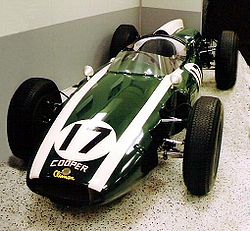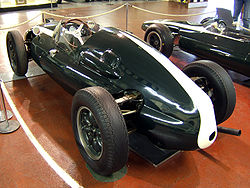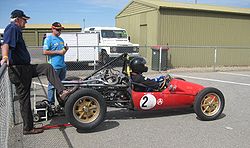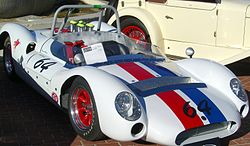- Cooper Car Company
-
Cooper 
Full name  Cooper Car Company
Cooper Car CompanyBase  Surbiton, Surrey, United Kingdom
Surbiton, Surrey, United KingdomFounder(s)  Charles Cooper
Charles Cooper
 John Cooper
John CooperNoted drivers  Stirling Moss
Stirling Moss
 Maurice Trintignant
Maurice Trintignant
 Jack Brabham
Jack Brabham
 Bruce McLaren
Bruce McLaren
 John Surtees
John Surtees
 Jochen Rindt
Jochen Rindt
 Pedro Rodríguez
Pedro RodríguezFormula One World Championship career Debut 1950 Monaco Grand Prix Races competed 129 Constructors' Championships 2 (1959, 1960) Drivers' Championships 2 (1959, 1960) Race victories 16 Pole positions 11 Fastest laps 14 Final race 1969 Monaco Grand Prix  This standard Cooper-Climax T53 F1 was donated by Jim Hall to the IMS in 1969. It is painted to look like Jack Brabham's 1961 Cooper-Climax T54, the car that began the rear-engine revolution at the Indianapolis 500. The real car is displayed at the Marconi Automotive Museum in Tustin, California.
This standard Cooper-Climax T53 F1 was donated by Jim Hall to the IMS in 1969. It is painted to look like Jack Brabham's 1961 Cooper-Climax T54, the car that began the rear-engine revolution at the Indianapolis 500. The real car is displayed at the Marconi Automotive Museum in Tustin, California.
 A rear three-quarter picture of a Cooper T51, the first World Championship-winning mid-engined Formula One car.
A rear three-quarter picture of a Cooper T51, the first World Championship-winning mid-engined Formula One car.
The Cooper Car Company was founded in 1946 by Charles Cooper and his son John Cooper. Together with John's boyhood friend, Eric Brandon, they began by building racing cars in Charles' small garage in Surbiton, Surrey, England in 1946. Through the 1950s and early 1960s, they reached auto racing's highest levels as their rear-engined, single-seat cars altered the face of Formula One and the Indianapolis 500, and their Mini Cooper dominated Rally racing. Thanks in part to Cooper's legacy, Britain remains the home of a thriving racing industry, and the Cooper name lives on in the Cooper versions of the Mini (BMW) production cars that are still built in England but are now owned and marketed by BMW.
The first cars built by the Coopers were single-seat 500cc Formula 3 racing cars driven by John Cooper and Eric Brandon and powered by a JAP motorcycle engine. Since materials were in short supply immediately after World War II, the prototypes were constructed by joining two old Fiat Topolino front-ends together. According to John Cooper, the stroke of genius that would make the Coopers an automotive legend—the location of the engine behind the driver—was merely a practical matter at the time. Because the car was powered by a motorcycle engine, they believed it was more convenient to have the engine in the back, driving a chain.
Called the Cooper 500, this car's success in hillclimbs and on track, including Eric winning the first post war motor race at Gransden Lodge airfield, quickly created demand from other drivers (including, over the years, Stirling Moss, Peter Collins, Jim Russell, Ivor Bueb, Ken Tyrrell and Bernie Ecclestone) and led to the establishment of the Cooper Car Company to build more. The business grew by providing an inexpensive entry to motorsport for seemingly every aspiring young British driver, and the company became the world's first and largest post-war, specialist manufacturer of racing cars for sale to privateers.
Cooper built over 300 F3 cars and dominated the category, winning 64 out of 78 major races between 1951 and 1954. This volume of construction was unique and enabled the company to grow into the senior categories; it was with a modified Cooper 500 chassis, a T12 model, that Cooper had its first taste of top-tier racing when Harry Schell qualified for the 1950 Monaco Grand Prix. Though Schell retired in the first lap, this marked the first appearance of a rear-engined racer at a Grand Prix event since the end of WWII.
The front-engined Formula Two Cooper Bristol model was introduced in 1952. Various iterations of this design were driven by a number of legendary drivers - among them Juan Manuel Fangio and Mike Hawthorn - and furthered the company's growing reputation by appearing in Grand Prix races, which at the time were run to F2 regulations. It wasn't until the company began building rear-engined sports cars in 1955 that they really became aware of the benefits of having the engine behind the driver. Based on the 500cc cars and powered by a modified Coventry Climax fire-pump engine, these cars were called "Bobtails." With the center of gravity closer to the middle of the car, they found it was less liable to spins and much more effective at putting the power down to the road, so they decided to build a single-seater version and began entering it in Formula 2 races.
Contents
Rear-engined revolution
Jack Brabham raised some eyebrows when he took sixth place at the 1957 Monaco Grand Prix in a rear-engined Formula 2 Cooper. When Stirling Moss won the 1958 Argentine Grand Prix in Rob Walker's privately-entered Cooper and Maurice Trintignant duplicated the feat in the next race at Monaco, the racing world was stunned and a rear-engined revolution had begun. The next year, 1959, Brabham and the Cooper works team became the first to win the Formula One World Championship in a rear-engined car. Both team and driver repeated the feat in 1960, and every World Champion since has been sitting in front of his engine.
Brabham took one of the Championship-winning Cooper T53 "Lowline" to Indianapolis Motor Speedway for a test in 1960, then entered the famous 500-mile race in a larger, longer and offset car based on the 1960 F1 design. Arriving at the Speedway 5 May 1961, the "funny" little car from Europe was mocked by the other teams, but it ran as high as third and finished ninth. It took a few years, but the Indianapolis establishment gradually realized the writing was on the wall and the days of their front-engined roadsters were numbered. Beginning with Jim Clark, who drove a rear-engined Lotus in 1965, every winner of the Indianapolis 500 has had the engine in the back. The revolution begun by the little chain-driven Cooper 500 was complete.
Once every Formula car manufacturer began building rear-engined racers, the practicality and intelligent construction of Cooper's single-seaters was overtaken by more sophisticated technology from Lola, Lotus, BRM and Ferrari. The Cooper team's decline was accelerated when John Cooper was seriously injured in a road accident in 1963 driving a twin-engined Mini and Charles Cooper died in 1964.
After the death of his father, John Cooper sold the Cooper Formula One team to the Chipstead Motor Group in April 1965. Their final Formula One victory was achieved by Mexican driver Pedro Rodríguez at the 1967 South African Grand Prix in a Cooper T81. In all, Coopers participated in 129 Formula One World Championship events in nine years, winning 16 races.
Besides Formula One cars, Cooper offered a series of Formula Junior cars. These were the T52, T56, T59 and T67 models. Ken Tyrrell ran a very successful team with John Love and Tony Maggs as his drivers. Following the demise of Formula Junior, Ken Tyrrell tested Jackie Stewart in a Formula Three car, a Cooper T72. This test at the Goodwood Circuit marked the start of partnership which dominated motorsport later on.
In October 2009, Mike Cooper, the son of John Cooper launched Cooper Bikes, the bicycle division of the Cooper Car Company.
Cooper Car Company Grand Prix results
(key) (results in bold indicate pole position; results in italics indicate fastest lap)
Year Chassis Engine Tyres Driver 1 2 3 4 5 6 7 8 9 10 11 12 Points WCC 1953 T20
T23
T21Bristol BS1 2.0 L6
Alta GP 2.5 L4D ARG 500 NED BEL FRA GBR GER SUI ITA n/a n/a[a]  Alan Brown
Alan Brown9  John Barber
John Barber8  Adolfo Schwelm Cruz
Adolfo Schwelm CruzRet  Stirling Moss
Stirling Moss9 Ret 6 13 1955 T40 Bristol BS1 2.0 L6 D ARG MON 500 BEL NED GBR ITA n/a n/a[a]  Jack Brabham
Jack BrabhamRet 1957 T43 Climax FPF 2.0 L4
Climax FPF 1.5 L4A ARG MON 500 FRA GBR GER PES ITA n/a n/a[a]  Jack Brabham
Jack Brabham6 7[b]/ Ret Ret 7  Les Leston
Les LestonDNQ  Mike MacDowel
Mike MacDowel7[b]  Roy Salvadori
Roy Salvadori5 Ret Ret 1958 T45
T44Climax FPF 2.0 L4
Climax FPF 1.5 L4D ARG MON NED 500 BEL FRA GBR GER POR ITA MOR 31 3rd  Jack Brabham
Jack Brabham4 8 Ret 6 6 Ret 7 Ret 11  Roy Salvadori
Roy SalvadoriRet 4 8 11 3 2 9 5 7  Ian Burgess
Ian BurgessRet  Jack Fairman
Jack Fairman8  Bruce McLaren
Bruce McLaren5 13 1959 T51 Climax FPF 2.5 L4 D MON 500 NED FRA GBR GER POR ITA USA 40
(53)1st  Bruce McLaren
Bruce McLaren5 5 3 Ret Ret Ret 1  Jack Brabham
Jack Brabham1 2 3 1 Ret Ret 3 4  Masten Gregory
Masten GregoryRet 3 Ret 7 Ret 2  Giorgio Scarlatti
Giorgio Scarlatti12 1960 T51
T53Climax FPF 2.5 L4 D ARG MON 500 NED BEL FRA GBR POR ITA USA 48
(58)1st  Bruce McLaren
Bruce McLaren1 2 Ret 2 3 4 2 3  Jack Brabham
Jack BrabhamRet DSQ 1 1 1 1 1 4  Chuck Daigh
Chuck DaighRet  Ron Flockhart
Ron FlockhartRet 1961 T55
T58Climax FPF 1.5 L4
Climax FWMV 1.5 V8D MON NED BEL FRA GBR GER ITA USA 14
(18)4th  Bruce McLaren
Bruce McLaren6 12 Ret 5 8 6 3 4  Jack Brabham
Jack BrabhamRet 6 Ret Ret 4 NC Ret Ret 1962 T60
T55Climax FWMV 1.5 V8
Climax FPF 1.5 L4D NED MON BEL FRA GBR GER ITA USA RSA 29
(37)3rd  Bruce McLaren
Bruce McLarenRet 1 Ret 4 3 5 3 3 2  Tony Maggs
Tony Maggs5 Ret Ret 2 6 9 7 7 3  Timmy Mayer
Timmy MayerRet 1963 T66 Climax FWMV 1.5 V8 D MON BEL NED FRA GBR GER ITA USA MEX RSA 25
(26)5th  Bruce McLaren
Bruce McLaren3 2 Ret 12 Ret Ret 3 11 Ret 4  Tony Maggs
Tony Maggs5 7 Ret 2 9 Ret 6 Ret Ret 7 1964 T73
T66Climax FWMV 1.5 V8 D MON NED BEL FRA GBR GER AUT ITA USA MEX 16 5th  Phil Hill
Phil Hill9 8 Ret 7 6 Ret Ret Ret 9  Bruce McLaren
Bruce McLarenRet 7 2 6 Ret Ret Ret 2 Ret 7 1965 T77
T73Climax FWMV 1.5 V8 D RSA MON BEL FRA GBR NED GER ITA USA MEX 14 5th  Bruce McLaren
Bruce McLaren5 5 3 Ret 10 Ret Ret 5 Ret Ret  Jochen Rindt
Jochen RindtRet DNQ 11 Ret 14 Ret 4 8 6 Ret 1966 T81 Maserati 9/F1 3.0 V12 D MON BEL FRA GBR NED GER ITA USA MEX 30
(35)3rd  Richie Ginther
Richie GintherRet 5  Jochen Rindt
Jochen RindtRet 2 4 5 Ret 3 4 2 Ret  John Surtees
John SurteesRet Ret Ret 2 Ret 3 1  Chris Amon
Chris Amon8  Moisés Solana
Moisés SolanaRet 1967 T81
T81B
T86Maserati 9/F1 3.0 V12
Maserati 10/F1 3.0 V12F RSA MON NED BEL FRA GBR GER CAN ITA USA MEX 28 3rd  Jochen Rindt
Jochen RindtRet Ret Ret 4 Ret Ret Ret Ret 4 Ret  Pedro Rodríguez
Pedro Rodríguez1 5 Ret 9 6 5 8 6  Alan Rees
Alan Rees9  Richard Attwood
Richard Attwood10  Jacky Ickx
Jacky Ickx6 Ret 1968 T81B
T86
T86B
T86CMaserati 10/F1 3.0 V12
BRM P142 3.0 V12
Alfa Romeo T33 3.0 V8F RSA ESP MON BEL NED FRA GBR GER ITA CAN USA MEX 14 7th  Brian Redman
Brian RedmanRet 3 Ret  Ludovico Scarfiotti
Ludovico ScarfiottiRet 4 4  Lucien Bianchi
Lucien Bianchi3 6 Ret Ret NC Ret Ret  Vic Elford
Vic Elford4 Ret Ret Ret 5 Ret 8  Johnny Servoz-Gavin
Johnny Servoz-GavinRet  Robin Widdows
Robin WiddowsRet [a] ^ The Constructors Championship not awarded until 1958.
[b] ^ Shared Drive.
Results of other Cooper cars
(key) (Results in bold indicate pole position; results in italics indicate fastest lap.)
Year Entrant/s Chassis/ Engine Tyres Driver/s 1 2 3 4 5 6 7 8 9 10 11 12 1958 ARG MON NED 500 BEL FRA GBR GER POR ITA MOR Rob Walker Racing Team T43
T45Climax FPF 2.0 L4 C  Stirling Moss
Stirling Moss1  Maurice Trintignant
Maurice Trintignant1 9 8 3 8 Ret Ret  Ron Flockhart
Ron FlockhartDNQ Scuderia Centro Sud T43 Climax FPF 1.5 L4 D  Wolfgang Seidel
Wolfgang SeidelRet Mini Legacy
As the company's fortunes in Formula One declined, however, the John Cooper-conceived Mini Cooper -- introduced in 1961 as a development of the Alec Issigonis-designed British Motor Corporation Mini with a more powerful engine, new brakes and a distinctive livery—continued to dominate in saloon car and rally races throughout the 1960s, winning many championships and the 1964, 1965 and 1967 Monte Carlo Rallies.
Several different Cooper-marked versions of the Mini and various Cooper conversion kits have been, and continue to be, marketed by various companies. The current BMW MINI, in production since 2001, has Cooper and Cooper S models and a number of John Cooper Works tuner packages.
Coopers Garage
On 1 April 1968, John Cooper leased the building, 243 Ewell Road,[1] to the Metropolitan Police and the local Traffic Division (V Victor) moved in. They would stay there for the next twenty-five years and 'TDV' would become one of the busier police garages. In August 1968, they were supplied with the two Mini Coopers index numbers PYT767F and PYT768F. The centre boss of the steering wheel was replace by a speaker and microphone and a PTT transmitter switch, was added to the steering column. The sight of a six-foot bobby getting into the mini greatly amused the locals. The vehicles were trialled for a number of months, but no orders were placed for other garages.
See also
- GPL Driveable, detailed simulations of Cooper's T81 and T77 F1 cars.
References
- John Cooper Works
- John Cooper - A Very British Marque, A Very British Man
- John Cooper: The Man Who Beat Italia
- Cooper profile at The 500 Owners Association
- John Cooper (1977). The Grand Prix Carpetbaggers: The Autobiography of John Cooper. Doubleday. ISBN 0-385-03081-9
- Cooper Cars, by Doug Nye, 1983, Osprey Publishing, 2003, Motorbooks International
Notes
Sporting positions Preceded by
VanwallFormula One Constructors' Champion
1959-1960Succeeded by
FerrariFounders: Charles Cooper • John Cooper
Designers: Owen Maddock • Jack Brabham • Eddie Stait • Derrick White
Cars
Formula One/Two: 1000/1100 • Cooper-Bristol • T41 • T43 • T44 • T45 • T51 • T53 • T55 • T58 • T60 • T63 • T66 • T71 • T73 • T75 • T77 • T80 • T81 • T82 • T84 • T86 • T91
Tasman: T55 • T62 • T70 • T79
Formula Three/Junior: 500 • T52 • T56 • T59 • T65/T67 • T72 • T76 • T83 • T85
Other: T54 (IndyCar) • T87 (hillclimb) • T88 (Formula C) • T90 (Formula 5000)
Sportscars: Cooper-MG • Cooper-Jaguar • Bobtail • Monaco • MiniFormula One World Constructors' Champions Categories:- Formula One constructors
- Formula One entrants
- Motor vehicle manufacturers of the United Kingdom
- British auto racing teams
- British racecar constructors
- Formula Two constructors
Wikimedia Foundation. 2010.


